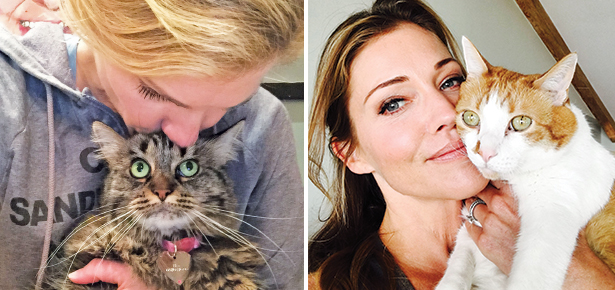

Tricia Helfer Knows Cats
And she wants to help you understand them too
Tricia Helfer—actress, supermodel, and serious cat person—answers your most pressing cat questions
Q: I’d like to consider fostering cats for my local shelter, but I’m not sure my own cat with like it. How can I determine if I should give it a go?
Each cat is an individual and different when it comes to accepting others into her home. I have some cats that are pretty much welcoming and some that are not happy campers at all when it comes to new arrivals. I think the best way to get started is to meet with your local shelter and tell them your concerns. Tell them that you’d really like to help out, but don’t know how it will go down with your own cat. They may start you off with a friendly foster, a cat that gets along well with others. Generally, it will be your own cat that has a problem with a new cat in his territory, but sometimes it’s also the foster cat with the bravado. Just like people, not all are going to get along. If you decide to go ahead, don’t just bring the foster cat in and shove the cats in front of each other. (Health checks also need to be done to make sure the foster isn’t bringing anything in before you integrate them.) Even with an all clear, it’s best to keep them separate to begin with anyway. Simple things like switching the blankets/towels in one your cat’s area with the blankets/towels in the foster cat’s room will help the cats get to know each other’s scent before they are face to face. Smell is super-important for cats. Have you noticed, if you have more than one cat, that the others will hiss at the one you took to the vet? This happens because the cats smell unfamiliar scents on that cat. Same with a new cat coming in—the resident cats will hiss and growl. There is a certain amount of letting cats be cats that has to be allowed—they have to do their natural dance of figuring out who the other one is. Obviously you don’t want it to be violent, but a little testiness while they get to know each other is natural and okay. Just follow the aforementioned “getting to know each other” guidelines and limit their unsupervised interaction until they’re sort of just slightly growling at each other. Past that, they’ll likely start to be friends, or at least continue to ignore each other.
Q: My husband and I inherited my Grandma’s cat. Any tips on helping him feel comfortable in a new home full of new smells and new people?
First off, I commend you for welcoming your Grandmother’s cat! There are so many sad stories of animals being dropped off at shelters or abandoned completely in situations like yours.
Coming into a new environment can be stressful. It is often a good idea to first bring the cat into a smaller room that is dedicated to him. He’ll likely be stressed still, but he’ll get acclimated to his smaller surroundings. If you can, keep the food/water on the other side of the room from the litter. Just like you probably don’t eat by the toilet, he won’t really want to either. Be attentive, go in to the room, bring a toy to play with—let him suss you out. But don’t be upset if he’s not immediately a lover or if he’s shy. It can take awhile. Once he seems fairly comfortable in this smaller space (it could be a few days), you can let him out to explore the rest of the house. It’s a good idea to do this during a quiet time. Maybe you’re heading out so he’ll have the opportunity to look around casually on his own terms, or you are there, but calmly reading a book or sleeping or watching TV. He may hide a bit, but he’ll know his safe place, so keep that door open. Gradually, once he’s comfortable, you’ll be able to move his food/water and litter stations. Rushing a cat to feel comfortable is usually an exercise in futility. Remember that all cats are different—some integrations are super easy, others not so much, so be patient.
Q: How do you suggest I deal with having friends over who are allergic to cats and/or don’t like them? My cats are like my family and I don’t feel comfortable locking them away, but I also don’t want to make my friends uncomfortable. What should I do?
I’ve faced this many times. I believe that my house is my house, and my animals are part of my home, so whomever is coming over needs to realize that. There are people though that are terribly allergic, and I’m accommodating to them. I will absolutely put my cats in another area of the house, and will vacuum and so forth. Then there are people that say they are allergic, but really aren’t; they just don’t like animals. Usually those people aren’t at my house. But, if they are, I look at it like my cats wouldn’t necessarily want to be around them either. Quite a few of my cats don’t like visitors anyway, so locking them away in their safe zone, with food/water and litter is actually more relaxing for them anyway. Basically, if people are coming over and I don’t feel I can keep control of the door being opened, or a friend coming over who is allergic, the cats are away safely. If someone drops by and expects me to “get rid of my cats,” they are the ones that get to go away instead.
Q: How does scratching work? If I have a scratching post does that mean I never have to clip my cat’s claws?
Scratching is natural for cats. It’s something they will always do. Scratching posts are great, but it doesn’t mean you won’t have to clip your cat’s claws. Definitely the more opportunity cats have to scratch on scratching posts/scratching toys, the less your furniture will be targeted. Depending on the size of your place, you may have to have more than one or two posts.
There are also some good training items like sticky tape that will help teach your cat not to scratch certain objects. This big double-sided tape strip sticks to furniture and will slightly stick to your cat if they try to scratch there. Putting this tape on the corners of furniture/places you don’t want your cats to scratch can be really helpful in training them where is okay to scratch. [Pioneer Pet makes awesome cat-dettering furniture strips called Sticky Paws.—Ed.] You can also try rubbing catnip on the scratching posts to attract scratching in that area.
Q: What are the best ways for me to help cats if I am unable to adopt more? I’m already at four, which, given my apartment size and resources, is about my max but I’d still like to help cats in need.
Great that you realize your limits but still want to help! Look up your neighbourhood shelter and decide how you can help out. It could be donating funds or being more hands-on, like volunteering time, either with smaller rescue groups or city shelters, or working with organizations dealing with feral cat colonies and spay/neuter/release programs. Volunteering can be as simple as going by to spend time with the animals and giving them some love, or more involved, like transporting cats to vet visits and helping out with cleaning. Spring/summer is always bottle-feeding baby time and volunteers are needed around the clock to bottle feed the tiny kittens. If you decide to work with a feral colony charity, you may help out on the streets, trapping ferals and making sure they get spayed/neutered, giving them a temporary home (such as a bathroom in your apartment!) to recover in before they are released into a feral colony. Most of the ways to help will require a short introduction and learning period with the shelter, so you can learn how to best lend a hand (and also so they know they can trust you). You can also meet some really great people this way too!
Join the newsletter and never miss out on cat content again!
"*" indicates required fields
By clicking the arrow, you agree to our web Terms of Use and Privacy & Cookie Policy. Easy unsubscribe links are provided in every email.






